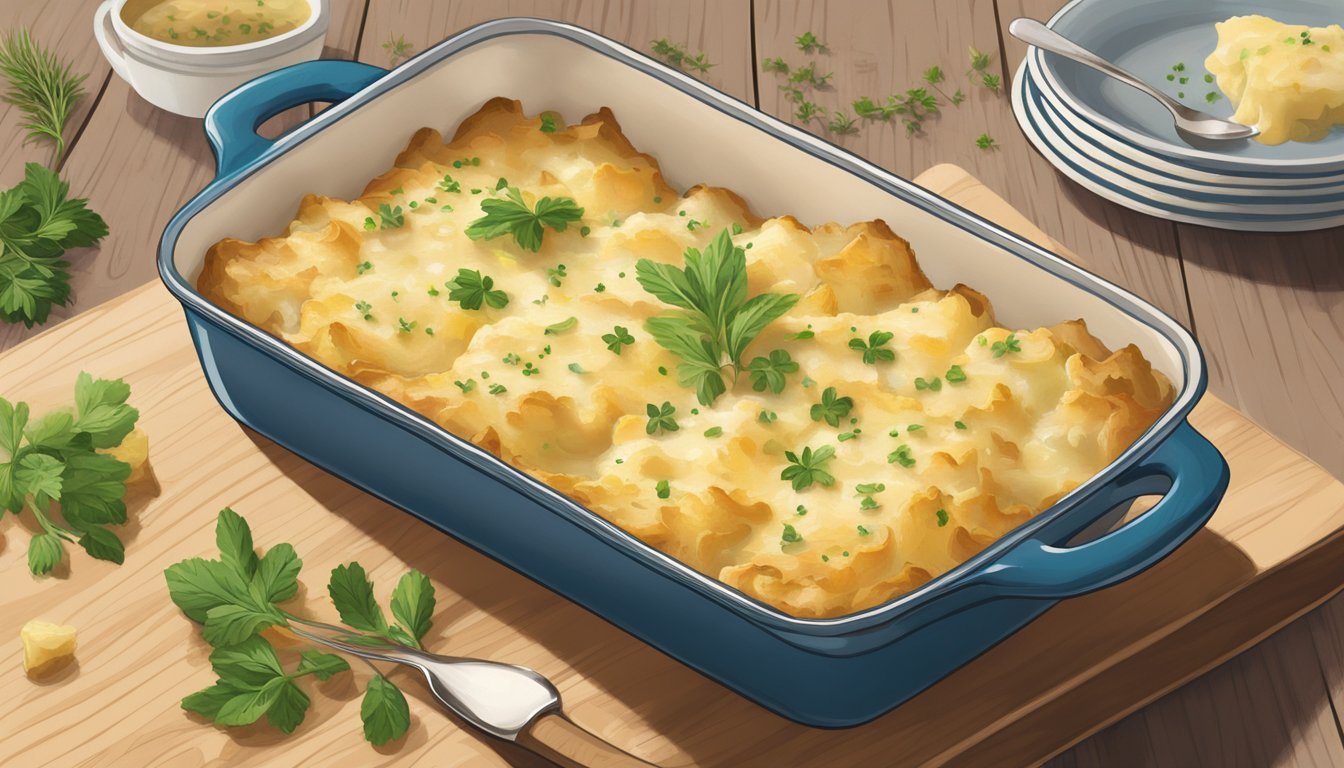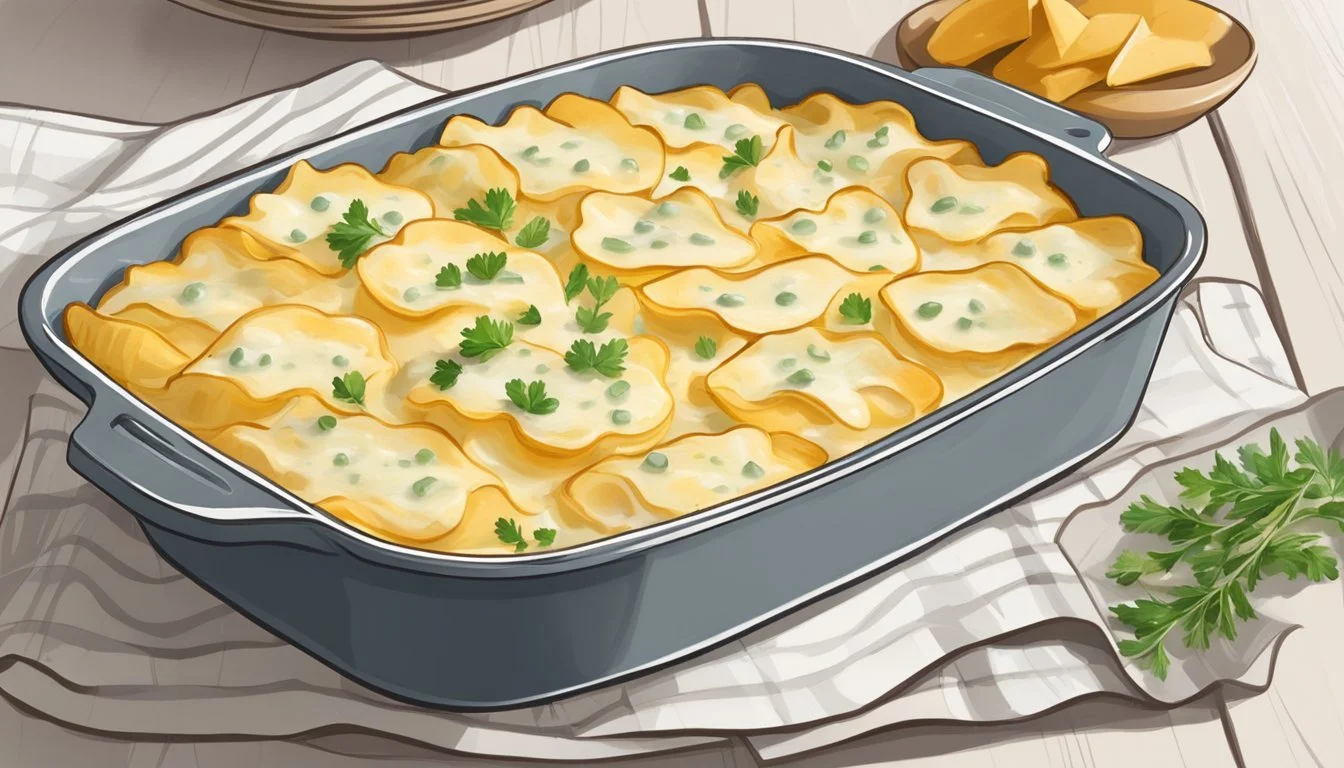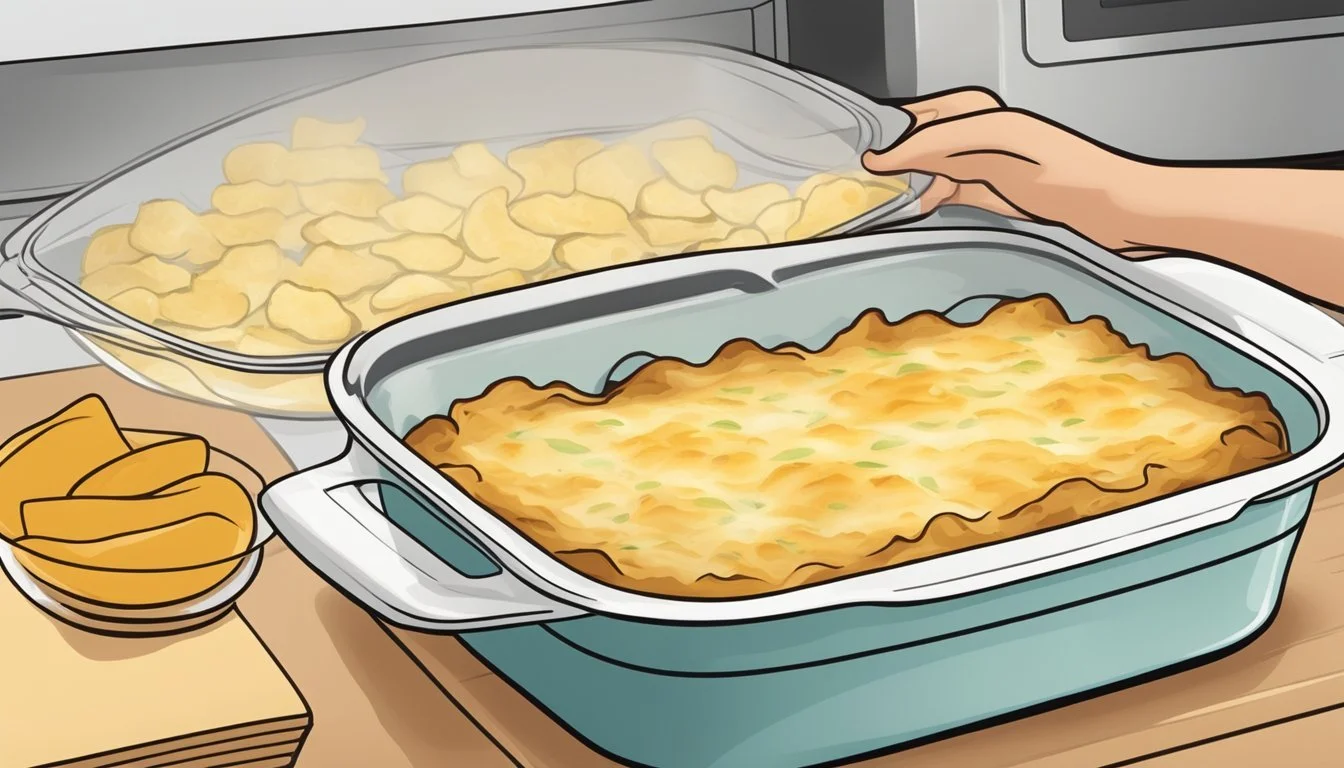How to Reheat Gluten-Free Scalloped Potatoes
Best Methods and Tips
Nothing beats the comforting taste of scalloped potatoes, especially when they are gluten-free and perfectly reheated. To reheat gluten-free scalloped potatoes effectively, preheat your oven to 325°F (160°C), and let the potatoes come to room temperature before placing them in the oven. This ensures even heating and helps preserve the dish’s creamy texture.
Sprinkle a bit of milk over the top of the potatoes to maintain their moisture, then cover the baking dish with foil. Warm the dish for approximately 20 minutes, removing the foil in the last 5 minutes to allow the top to brown nicely. These simple steps ensure your leftover scalloped potatoes retain their deliciousness.
The oven method is preferred for reheating scalloped potatoes as it keeps the creamy layers and soft texture intact, unlike microwaving, which can often make them dry. With these tips, enjoying your gluten-free scalloped potatoes is just as delightful the second time around.
Understanding Gluten-Free Scalloped Potatoes
Gluten-free scalloped potatoes are a popular comfort food made without wheat-based ingredients, making them suitable for those with gluten sensitivities or celiac disease. This dish is often creamy and cheesy, offering a delicious gluten-free side dish for various meals.
Difference Between Scalloped and Au Gratin Potatoes
Scalloped potatoes and au gratin potatoes often confuse many, but there are distinct differences. Scalloped potatoes are typically made with a cream sauce, while au gratin potatoes incorporate cheese, usually layered between the potato slices and on top.
Au gratin dishes are richer due to the added cheese. Both versions can be made gluten-free by using gluten-free flour for thickening the sauce and ensuring all ingredients are certified gluten-free.
Choosing the Right Potatoes
Choosing the right type of potatoes is crucial for perfect gluten-free scalloped potatoes. Russet or Yukon Gold potatoes are ideal due to their starch content, which helps create a creamy texture.
Russets provide a fluffier consistency, while Yukon Golds offer a buttery taste. Avoid waxy potatoes like red potatoes as they can stay firm and affect the dish's texture. Slice potatoes thinly and uniformly for even cooking.
Dairy-Free and Gluten-Free Options
For those needing a dairy-free and gluten-free recipe, several substitutions can be made. Use plant-based milks such as almond or coconut milk instead of dairy milk.
Nutritional yeast can replace cheese to provide a cheesy flavor without dairy. Utilize gluten-free and dairy-free butter alternatives for the sauce. Ensure all substitutions are certified gluten-free to avoid cross-contamination.
Essential Ingredients
Creating the perfect gluten-free scalloped potatoes requires careful attention to ingredients such as cheese varieties, seasonings, and thickening alternatives. Each component plays a crucial role in achieving a balance of flavor and texture.
Selecting Cheese Varieties
Cheese is a key ingredient, contributing to both flavor and creaminess. Common choices are Parmesan cheese and Cheddar cheese.
Parmesan cheese adds a sharp, nutty flavor. It's best used freshly grated for maximum taste.
Cheddar cheese brings a robust, creamy texture and a hint of tanginess. Both mild and sharp varieties work well, depending on the desired intensity of flavor.
Opt for high-quality, naturally gluten-free cheese to avoid contamination. Combining these cheeses can elevate the dish, providing balance and complexity.
Importance of Seasoning
Seasoning makes a substantial difference in the taste profile. Essential seasonings include:
Salt: Enhances the natural flavors of other ingredients.
Black pepper: Adds mild heat and complexity.
Garlic: Fresh minced garlic or garlic powder brings a rich, aromatic depth.
Onion powder or finely chopped onions: Contribute a subtle sweetness and pungency.
Dried thyme: Lends a herby, slightly minty note, complementing the creaminess.
Seasoning the cream sauce adequately ensures each bite is flavorful and rich, making it crucial not to skimp on these ingredients.
Gluten-Free Thickening Alternatives
The traditional flour roux doesn't work for gluten-free diets, so alternatives are necessary. Gluten-free all-purpose flour is a versatile substitute.
Cornstarch or tapioca starch can also be used to thicken sauces effectively. These alternatives should be mixed with a small amount of cold liquid before being added to the hot mixture to prevent clumping.
Using these thickeners ensures a smooth, creamy consistency without the gluten, maintaining the dish's classic rich texture while catering to dietary restrictions.
Preparation Techniques
Reheating gluten-free scalloped potatoes requires careful preparation, focusing on creating a smooth, creamy sauce, achieving uniform potato slices, and precise layering.
Creating the Creamy Sauce
A creamy sauce is fundamental. Begin with melting butter or margarine over medium heat. Use gluten-free flour to form a roux, adding heavy cream or milk gradually, whisking continuously to prevent lumps.
Season the sauce with onion powder, garlic powder, salt, pepper, and dried thyme. For a dairy-free option, combine almond milk with chicken broth. Simmer until the mixture thickens, ensuring a smooth texture.
Mastering Thinly Sliced Potatoes
Uniform slices ensure even cooking. Use a mandoline slicer or a sharp knife to cut the potatoes into 1/8-inch slices.
A mandoline guarantees consistent thickness, improving the dish's texture. Safety is paramount; always use the guard. If using a knife, take time to slice evenly.
Assembling the Layers
Proper layering is crucial. Grease a baking dish and spread a thin layer of the creamy sauce at the bottom. Arrange half of the sliced potatoes evenly.
Pour half of the remaining sauce over the potatoes, then sprinkle with cheese for extra flavor. Repeat the process with the remaining potatoes and sauce. Cover with foil and bake, uncovering in the final minutes for a golden top.
Baking the Scalloped Potatoes
Baking gluten-free scalloped potatoes ensures they are tender and develop a golden crust. Attention to baking time and texture is crucial.
Determining the Right Baking Time
The optimal baking time for scalloped potatoes depends on their thickness and the oven temperature. Preheat the oven to 375°F. If using Yukon Gold potatoes sliced to 1/8 inch thick, bake for 60-75 minutes.
Cover the dish with aluminum foil for the first 60 minutes to prevent excessive browning. Remove the foil for the remaining time to create a golden crust.
Using a knife or fork, check for doneness. The potatoes should be fork-tender. Adjust the baking time if necessary, especially for thicker slices.
Achieving the Perfect Texture
Achieving the right texture is essential for gluten-free scalloped potatoes. Use a mix of whole milk and heavy cream to create a creamy sauce.
Add gruyere cheese for richness and a slightly nutty flavor. Layer the potato slices evenly to ensure uniform cooking. Place a portion of the cream mixture on each layer.
Bake the dish covered initially to allow the potatoes to steam and soften. Uncover it towards the end to develop a golden crust. Use a small knife to check the softness. For better results, let the dish sit for a few minutes after baking to set.
Proper Reheating Methods
For gluten-free scalloped potatoes, reheating correctly ensures they remain tasty and maintain the right texture. Different methods can be employed depending on your needs, such as the oven for even heating, the microwave for speed, or a skillet for crispiness.
Oven Reheating for Best Results
The oven method is ideal for reheating gluten-free scalloped potatoes due to its gentle and even heating.
Preheat the oven to 325°F (160°C). This temperature is low enough to warm the dish without drying it out.
Add moisture by sprinkling a small amount of milk over the potatoes, which helps maintain their creamy texture.
Cover the dish with foil to keep the heat uniform and prevent the top from browning too quickly.
Heat for 20-25 minutes, checking after 15 minutes to ensure the dish is warming evenly.
Using this method, the scalloped potatoes will retain their creaminess and avoid becoming soggy.
Microwave Tips for Quick Reheating
The microwave offers a fast way to reheat gluten-free scalloped potatoes, although it can make them a bit soggy.
Place the potatoes in a microwave-safe dish.
Cover with a microwave-safe lid or a damp paper towel to trap the steam.
Use 50% power settings to reheat. Start with 3-5 minutes, stirring halfway through.
Check the temperature and continue heating in short intervals if needed.
This method is speedy but requires careful attention to avoid overheating or drying out the edges.
Using a Skillet for Crispy Edges
Using a skillet can give the leftover gluten-free scalloped potatoes delightful crisp edges while reheating.
Add a small amount of oil or butter to a non-stick skillet.
Warm the skillet over medium heat.
Place the scalloped potatoes in an even layer in the skillet.
Cook for about 7-10 minutes, turning occasionally to ensure even heating and crispy edges.
This method adds a pleasant texture, especially if you enjoy a bit of crunch in your reheated leftovers.
Serving Suggestions
Gluten-free scalloped potatoes make an excellent side dish for a variety of meals. Their creamy texture and rich flavors complement many main courses.
With Steak
Pair the scalloped potatoes with a juicy, grilled steak. The combination of tender meat and creamy potatoes is satisfying and universally appealing.
Roasted Chicken
For a comforting family dinner, serve the potatoes alongside roasted chicken. The simplicity of roasted chicken allows the flavors of the scalloped potatoes to shine.
Glazed Ham
Especially during a holiday dinner, scalloped potatoes and glazed ham create a festive and harmonious plate. The sweetness of the ham balances the savory potatoes perfectly.
Vegetable Medley
For a lighter option, serve with a medley of steamed or roasted vegetables. The vegetables add a fresh contrast to the richness of the potatoes.
Here’s a quick look at some pairing ideas:
Main Course Why It Works Steak Rich, savory flavors complement each other Roasted Chicken Simple and comforting combination Glazed Ham Sweet and savory balance Vegetable Medley Light, fresh contrast
This versatility makes gluten-free scalloped potatoes a delightful addition to any meal, whether it’s a special occasion or an everyday family dinner.
Storing and Making Ahead
Storing Instructions: Keep any leftover scalloped potatoes in an airtight container. Store them in the refrigerator for up to 3-5 days. Ensure the dish is completely cooled before refrigerating to maintain texture and flavor.
Freeze: For longer storage, freeze the scalloped potatoes. Use a freezer-safe container or heavy-duty aluminum foil. Label with the date. They can be frozen for up to 3 months. Thaw overnight in the refrigerator before reheating.
Make Ahead: Prepare the dish up to the baking step. Cover tightly with plastic wrap or aluminum foil and store in the refrigerator for up to 24 hours. This helps in last-minute preparation.
Last-Minute Preparation: If short on time, pre-slice the potatoes and prep all ingredients in advance. Assemble quickly when ready to cook. This enables a swift transition from prep to oven without compromising taste or quality.
Pairing with Main Courses
When pairing gluten-free scalloped potatoes with main courses, consider both proteins and vegetarian options. Each pairing offers unique flavors that can enhance the dining experience. Let's look at some great matches for your special occasions.
Complementing Proteins with Scalloped Potatoes
Gluten-free scalloped potatoes pair excellently with various protein dishes. Roast chicken is a classic choice, especially for holiday meals like Thanksgiving and Christmas. The creamy texture and rich flavor of the scalloped potatoes complement the savory and juicy roast chicken perfectly.
For a more robust option, consider pairing scalloped potatoes with prime rib. The tender, flavorful beef works harmoniously with the cheesy and creamy potatoes, creating a satisfying and rich meal often seen at festive gatherings.
Ham is another excellent option. Particularly during Easter, the sweet and salty flavor of a well-glazed ham enhances the scalloped potatoes' savory notes.
Grilled or roast pork also pairs wonderfully. The mild flavor of pork offers a good balance with the rich, often garlicky profiles of the scalloped potatoes, making it an ideal choice for a warm, hearty dinner.
Vegetarian Pairings
For those preferring vegetarian options, gluten-free scalloped potatoes can still shine. Stuffed bell peppers, filled with quinoa, black beans, and corn, bring vibrant flavors and textures that complement the creamy potatoes.
Consider pairing with grilled portobello mushrooms. The meaty texture and umami flavor of these mushrooms provide a substantial and satisfying meal alongside the rich scalloped potatoes.
Ratatouille, with its assortment of slow-cooked vegetables, works as a fantastic pairing. Its tangy and slightly sweet flavors contrast nicely with the creamy, cheesy potatoes.
Lastly, baked tofu cubes marinated in a savory herb mix can offer a protein-rich yet light pairing. The tofu's texture and flavor make for a balanced and nutritious meal alongside the indulgent scalloped potatoes.
Sharing Your Dish
When sharing gluten-free scalloped potatoes, presentation is key. Social media platforms like Instagram, Facebook, and Pinterest can help showcase your dish beautifully.
Photography Tips
Natural Light: Use daylight for clear, vibrant photos.
Angle: Shoot from above or at a 45-degree angle to highlight the layers.
Props: Add garnishes or utensils for context.
Engaging Posts
Captions: Describe the dish and its gluten-free benefit.
Hashtags: Use tags like #glutenfree, #scallopedpotatoes, and #homemade.
Serving at Gatherings
Scalloped potatoes can be a crowd-pleasing side dish. They are easy to portion and serve.
Serve in individual ramekins for an elegant touch.
Use a chalkboard menu sign highlighting the gluten-free aspect.
Place the dish in a central location for easy access.
Sharing your gluten-free scalloped potatoes thoughtfully ensures everyone enjoys both the taste and the story behind the dish.









